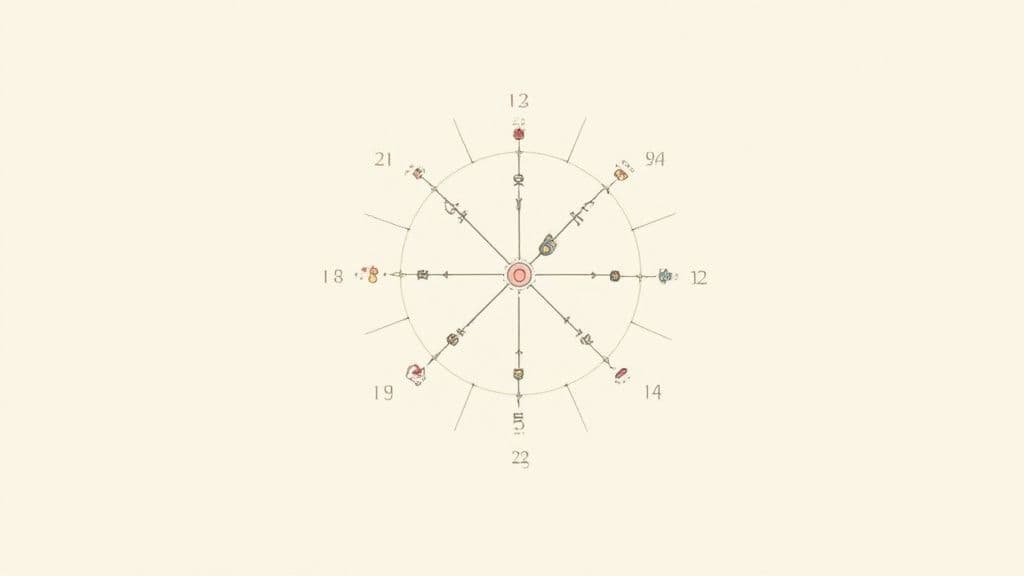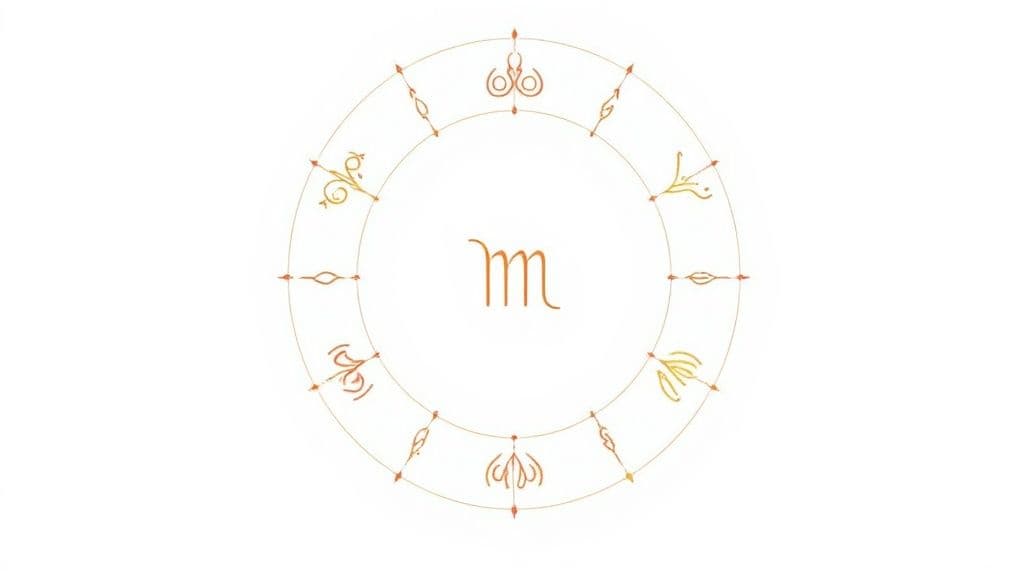Discover clear, practical ways to assess life path compatibility and strengthen your relationship. This guide compares Life Path Number numerology, Sun Sign astrology, MBTI, the Enneagram, Love Languages, Attachment Styles, Chinese Zodiac, and Vedic Astrology so you can choose tools that support better communication, deeper connection, and lasting harmony.
June 6, 2025 (6mo ago) — last updated November 8, 2025 (1mo ago)
Life Path Compatibility: 8 Methods Compared
Compare eight compatibility systems—numerology, astrology, MBTI, Enneagram, love languages, attachment styles, Chinese Zodiac, Vedic—to improve relationship insight.
← Back to blog
Life Path Compatibility: 8 Methods Compared
Summary: Explore eight compatibility systems—numerology, astrology, MBTI, Enneagram, love languages, attachment styles, Chinese Zodiac, and Vedic Astrology—to get practical relationship insight.
Introduction
Discover clear, practical ways to assess life path compatibility and strengthen your relationship. This guide compares Life Path Number numerology, Sun Sign astrology, MBTI, the Enneagram, Love Languages, Attachment Styles, Chinese Zodiac, and Vedic Astrology so you can choose tools that support better communication, deeper connection, and lasting harmony.
Finding Your Perfect Match: Exploring Compatibility Methods
Want deeper, more fulfilling relationships? Below are eight widely used systems people use to explore life path compatibility. Each method offers different insights—psychological, symbolic, practical, or spiritual—so you can combine approaches that fit your values and goals. For each system you’ll find how it works, strengths and limitations, and quick tips you can apply today.
1. Life Path Number Compatibility
Life Path Number compatibility, rooted in numerology, reduces your birth date to a single digit (1–9) to reveal core personality archetypes. Add the digits of your full birth date until you reach one digit (note Master Numbers 11, 22, 33 require special treatment). A Life Path Number highlights natural strengths and likely friction points, making it a quick tool for self-reflection and conversation starters.

Strengths:
- Easy to calculate and remember.
- Offers clear archetypes for describing tendencies.
Limitations:
- Overly reductive; human personality is more nuanced than nine categories.
- Lacks scientific validation; use it for insight, not as a verdict4.
Quick tips:
- Use full birth dates and note Master Numbers.
- Focus on complementary strengths rather than identical traits.
- Combine Life Path insights with psychological tools like attachment styles for balance.
Learn more: Life Purpose App – Life Path Reading
2. Astrological Sun Sign Compatibility
Sun sign compatibility compares zodiac signs and their elements (fire, earth, air, water) and modalities (cardinal, fixed, mutable). It’s an accessible starting point for understanding broad energetic patterns between two people.

Strengths:
- Widely understood and easy to use.
- Element and modality frameworks give fast, relatable insights.
Limitations:
- Based only on the sun; a full birth chart (including moon, Venus, Mars) gives a fuller picture.
- No strong scientific evidence that sun signs determine personality or relationship success4.
Quick tips:
- Check Venus and Mars placements for romance and desire.
- For a deeper read, get a synastry chart from a professional astrologer.
3. Myers‑Briggs Type Indicator (MBTI) Compatibility
The MBTI categorizes preferences across four dichotomies (E/I, S/N, T/F, J/P) to create 16 types. It’s useful for understanding communication styles, decision-making, and how partners balance each other.
Strengths:
- Practical for improving communication and teamwork.
- Widely used in coaching and workplaces.
Limitations:
- Reliability and validity are debated in academic literature; MBTI results can change over time and with different instruments3.
- Avoid rigid labeling; use types as starting points for growth, not as boxes.
Quick tips:
- Consider cognitive functions for deeper understanding.
- Use differences to grow: complementary preferences can balance a relationship.
4. Enneagram Type Compatibility
The Enneagram explores nine core motivations and fears, plus wings, instinctual variants, and stress/security movements. It’s powerful for recognizing deep motivators and predictable stress patterns.
Strengths:
- Explains underlying motivations and offers growth paths.
- Great for long-term relational work and emotional honesty.
Limitations:
- Accurate typing requires self-reflection and study.
- Can be misused to justify behavior rather than encourage growth.
Quick tips:
- Learn your core type, wing, and instinctual variant.
- Use knowledge of stress and security points to support your partner during hard times.
5. Love Languages Compatibility
Dr. Gary Chapman’s five love languages—Words of Affirmation, Quality Time, Physical Touch, Acts of Service, and Receiving Gifts—help clarify how partners feel loved and appreciated.

Strengths:
- Highly actionable; small changes create big effects.
- Easy to assess with a brief questionnaire.
Limitations:
- Simplifies complex emotional needs; many people value more than one language.
Quick tips:
- Take the official assessment together.
- Practice your partner’s primary language daily, especially during conflict.
6. Attachment Style Compatibility
Attachment styles—Secure, Anxious‑Preoccupied, Dismissive‑Avoidant, Fearful‑Avoidant—derive from attachment theory and explain how people relate in intimate bonds. Attachment frameworks are strongly supported in psychological research and offer practical pathways to healthier relationships1. Early research found roughly half of adults were categorized as securely attached, with the remainder showing patterns of anxiety or avoidance—insights that make attachment a practical focus for relationship work2.
Strengths:
- Research-backed framework for understanding relational patterns and healing.
- Directly applicable in therapy and self-work.
Limitations:
- Styles reflect developmental patterns and can change with intentional work.
Quick tips:
- Assess your attachment style honestly and practice secure behaviors.
- If needed, seek therapy to work through insecure patterns and build healthier dynamics.
Internal resources: Attachment Styles Guide | Couples Communication Exercises
7. Chinese Zodiac Compatibility
The Chinese zodiac pairs 12 animal signs with the five elements (Wood, Fire, Earth, Metal, Water) and yin-yang dynamics. Traditional four-pillar charts (year, month, day, hour) create a nuanced compatibility picture used across relationships and family contexts6.
Strengths:
- Rich cultural and symbolic detail; considers elemental interactions.
- Often used historically for matchmaking and family planning.
Limitations:
- Focus on birth year can miss personality detail; cultural interpretations vary.
Quick tips:
- Learn your full four-pillar chart for deeper insight.
- Use Chinese Zodiac guidance as cultural wisdom, not absolute rules.
Infographic: key animal-element interactions and compatibility triads.

8. Vedic Astrology (Kundali) Compatibility
Vedic Astrology uses Kundali Milan (Gunā Milan) and a 36-point system across eight categories to assess marital compatibility. It’s a detailed, spiritually oriented method commonly used in South Asian marriage decisions and spiritual counseling5.
Strengths:
- Comprehensive; considers spiritual, familial, and practical compatibility factors.
- Time-tested in cultural contexts where it’s practiced.
Limitations:
- Complex and often requires expert interpretation.
- Cultural and religious context matters; balance traditional advice with personal judgment.
Quick tips:
- Consult a qualified Vedic astrologer for accurate interpretation.
- Treat high or low scores as guidance, not destiny.
Comparing the Methods: Quick Reference
- Use numerology and sun signs for symbolic overviews.
- Use MBTI and the Enneagram for personality frameworks that help communication and growth.
- Use Love Languages and Attachment Styles for immediate relationship skills and healing; these are the most actionable tools.
- Use Chinese Zodiac and Vedic Astrology when cultural or spiritual resonance matters; pair them with modern tools for balance.
A combined approach—matching psychological tools (attachment, Enneagram) with symbolic systems (numerology, astrology) and actionable tools (love languages)—often yields the best practical results.
Which Compatibility System Is Right for You?
No single system answers everything. Choose methods that:
- Reflect your values and belief system.
- Offer practical steps you can apply today.
- Encourage growth rather than rigid labeling.
For personal readings and tools inspired by life path work, explore the Life Purpose App for guided Life Path readings and matching tools: Life Purpose App
Frequently Asked Questions
Q1: Are these systems scientifically proven?
A1: Attachment theory is well supported by decades of psychological research and clinical practice1. Other systems—like astrology and numerology—are symbolic frameworks without robust scientific evidence; use them for reflection and conversation rather than predictive science4.
Q2: Can two people with different systems still be compatible?
A2: Yes. Compatibility is multi-dimensional. Combining tools—for example, using attachment awareness for emotional safety and love languages for daily connection—creates practical pathways to stronger relationships.
Q3: How should I use these systems with a partner?
A3: Use them as neutral conversation starters. Share your results, discuss needs and differences, and create small, consistent experiments (for example, practice your partner’s love language for two weeks). If patterns cause distress, consider couples therapy.
Quick Q&A: Practical User Questions
Q: Which method gives the fastest relationship wins?
A: Love Languages and Attachment Styles are the most actionable—small, consistent changes here often improve satisfaction quickly.
Q: Which methods are best for deeper, long-term growth?
A: The Enneagram and attachment work support long-term growth and emotional insight; combine them with regular communication practices.
Q: Should I trust cultural systems like Chinese Zodiac or Vedic Astrology?
A: Use them for cultural or spiritual resonance and conversation. When decisions are important, pair traditional guidance with personal judgment and psychological tools.
Practical Bottomline Q&A
Q: What’s the single most practical step to improve compatibility?
A: Start with attachment awareness and one small daily practice from your partner’s love language to build safety and connection.
Q: How do I combine methods without confusion?
A: Treat symbolic systems as conversation starters and psychological tools as action plans. Pick one symbolic lens and one actionable tool to test for 30 days.
Q: When should we seek professional help?
A: If patterns of distress or repeated conflicts continue despite consistent effort, consult a therapist or a qualified practitioner in the relevant system.
Concise Q&A Sections (Bottom Summary)
1) Quick wins and first steps
Q: I want a fast improvement—where do I start? A: Identify your partner’s primary love language and practice it daily for two weeks. Combine that with honest talk about emotional needs and attachment tendencies.
2) Deeper growth and tough patterns
Q: We keep repeating the same fights—what helps long-term? A: Work with attachment awareness and Enneagram insight to name triggers and create a shared plan. Therapy or coaching can speed progress.
3) Mixing symbolic and scientific tools
Q: Can I use astrology or numerology alongside therapy tools? A: Yes. Use symbolic systems as conversation prompts and psychological tools as action plans. Keep cultural and personal values in mind.
Discover Your Life Purpose Today!
Unlock your true potential and find your life’s purpose.
